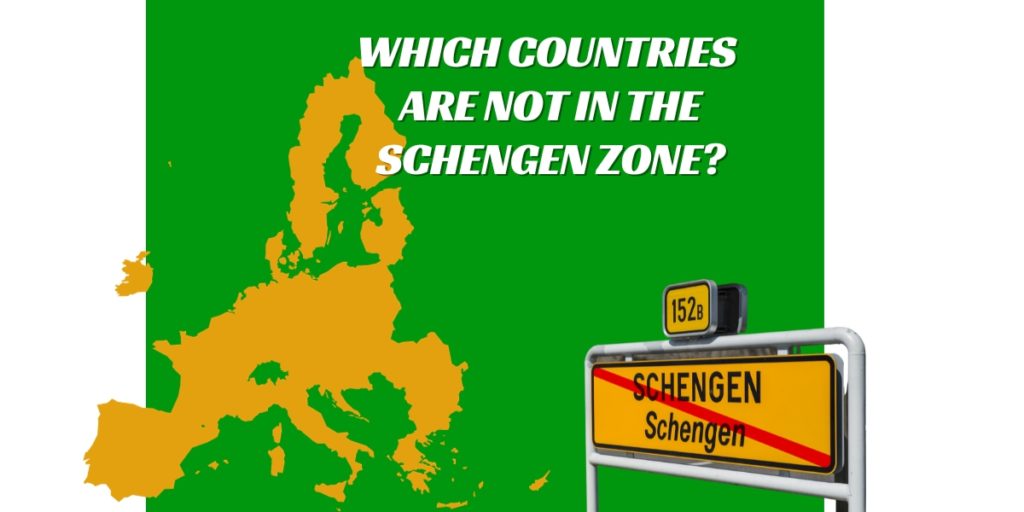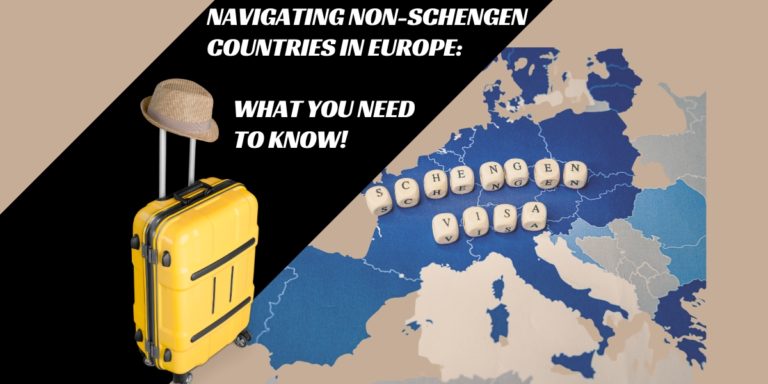Which countries are not in the Schengen zone?

Europe is a prominent place with many different cultures and beautiful scenery. But when it comes to traveling there, it’s more challenging than it seems. In some parts of Europe, you can travel between countries without showing your passport. Thanks to something called the Schengen Area. But, not all European countries are part of this agreement. To visit Europe, you must know which countries are not in the Schengen zone. This is important because it affects the visa you’ll need and how you plan your trip.
The Schengen Area symbolizes open borders and a shared visa policy, facilitating the free movement of people. Yet, certain nations maintain external border controls to protect their internal security. They have the option to reintroduce border controls as needed.
The countries not in the Schengen zone care greatly about their safety and independence. They want to control their borders and watch who’s coming in and out. They work together with other countries to fight crime that happens across borders. They also ensure justice can be done even if the crime goes from one country to another. They don’t want their borders to get in the way of catching criminals and making things right.
Travelers within the Schengen Area enjoy 180 days of unrestricted movement. At the same time, non-Schengen nations chart their unique course, engaging in dialogue and collaboration. Understanding the list of countries not in the Schengen zone reveals the complexity of European identities. And the delicate balance between internal security and international cooperation.
What is the Schengen Zone?
The Schengen Zone, a pivotal construct of the Common Visa Policy, merits our understanding. Its roots trace back to 1985 when it was set in motion within the quaint confines of Schengen, Luxembourg. This vital agreement caused a significant change in how people travel around Europe. It led to the removal of borders within some European countries. Making it possible to travel without showing your passport across a large part of the European Union. The Schengen Zone is set up in a way that makes it easy for people to move from one country to another without much trouble.
Today, this network of passport-free travel and multiple-entry visas includes 27 European countries. This arrangement benefits both the nomadic tourist and the permanent resident. But, the nature of this agreement is not limited to mere leisure or habitation.
In law enforcement and police cooperation, the Schengen Zone incorporates a sophisticated mechanism. The 180-day period is a critical facet of this arrangement. It permits visitors to remain within the Schengen Area for up to six months in a rolling year. Offering flexibility for individuals involved in leisure activities, business ventures, or cultural explorations.
When transgressions of the law occur, the Schengen Zone’s provisions also encompass a dynamic concept known as hot pursuit. This legal instrument empowers authorities to pursue and apprehend suspects across borders. Ensuring that no unlawful act goes unpunished within.
The Schengen Zone is a potent symbol of the success of a united Europe. It demonstrates the achievement of unrestricted movement by getting rid of internal borders. Also, providing multiple-entry visas and having innovative ways for police cooperation. This all happens within a powerful alliance of 27 nations.
Countries Outside the Schengen Zone
Below is a compilation of countries that are not included in the Schengen Area:
- Albania: A Balkan nation known for its rich history and stunning Adriatic coastline.
- Andorra: A tiny, mountainous nation nestled between Spain and France.
- Armenia: Situated right where Western Asia meets Eastern Europe.
- Azerbaijan: A nation that has the characteristics of both Eastern Europe and Western Asia.
- Belarus: A country in Eastern Europe with a historical connection to the Soviet Union.
- Bosnia and Herzegovina: Famous for its wide-ranging cultural traditions and stunning natural landscapes.
- Bulgaria: A country in the Balkans boasting a fascinating past and scenic terrains.
- Cyprus: An island nation in the Mediterranean with a mix of Greek and Turkish influences.
- Georgia: Found at the meeting point of Europe and Asia.
- Ireland: Even though Ireland is a member of the European Union, it opted not to become a part of the Schengen Area.
- Kosovo: A nation in the Balkans with a colorful past and a mix of various cultural influences.
- Macedonia (North Macedonia): Known for its ancient history and picturesque landscapes.
- Moldova: A compact Eastern European nation known for its flourishing wine traditions.
- Monaco: A tiny, wealthy city-state on the French Riviera. (Keep in mind that Monaco isn’t a Schengen member. But it maintains an open border with France, a Schengen country. This means you won’t receive a border stamp when crossing into Monaco.)
- Montenegro: A Balkan country known for its stunning Adriatic coast and mountainous landscapes.
- Romania: The place where you’ll find the Carpathian Mountains and the famous Dracula legend.
- Russia: The biggest nation on Earth, stretching across Eastern Europe and northern Asia.
- San Marino: One of the world’s smallest countries, landlocked by Italy.
- Serbia: A Balkan country with a rich history and diverse cultural influences.
- Turkey: Positioned between Europe and Asia, providing a diverse tapestry of history and culture.
- Ukraine: Famous for its Orthodox churches, the Black Sea coastline, and densely forested mountains.
- United Kingdom: Comprising England, Scotland, Wales, and Northern Ireland.
- Vatican City: The world’s smallest independent state, located within Rome.
Why It Matters
Understanding the visa regulations is essential for navigating the intricacies of non-Schengen countries. And the nuances surrounding the movement of persons at common borders. A savvy traveler should know internal border controls across these regions. Grasping the intricacies of preserving one’s legal status within the Schengen Area.
For those looking to extend their stay in Europe, it’s worth considering how to reset their Schengen time limit.
In Conclusion
It is important to remember the countries that fall outside this extensive region. Whether you’re planning an extended European journey or aiming for a more comprehensive grasp of visa rules. Being well-informed about both Schengen and non-Schengen countries can enhance the quality of your trip.
In the quest for a more enjoyable and hassle-free journey, CarTurf presents itself as a solution. It assists in the buying of a vehicle and manages the registration process. They also ensure your car is ready for your European adventure when you arrive. This not only means significant savings on rental car costs. But also grants you flexibility, enabling you to explore Europe at your own pace. To get in touch with CarTurf, visit MyCarTurf.com/contact. Wishing you safe and remarkable travels!





